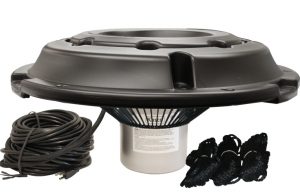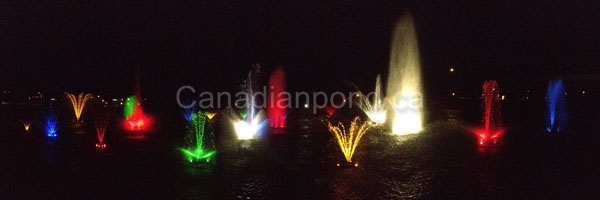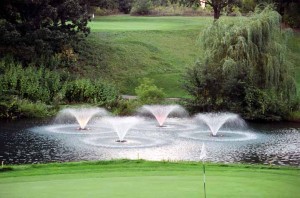Choosing the Right Floating Fountain for your Pond
 Maybe you’re thinking a floating fountain would ideal to provide aeration, circulation and a nice visual aspect to your pond? Here is what you should know and what needs to be considered before purchasing a fountain.
Maybe you’re thinking a floating fountain would ideal to provide aeration, circulation and a nice visual aspect to your pond? Here is what you should know and what needs to be considered before purchasing a fountain.
A Fountain Should Not be Considered as the Main Source of Aeration for Larger/Deeper Ponds
Fountains provide circulation and superficial aeration that may not be enough for the pond’s needs. Also, it is false to think circulation provides oxygen to the water. To maximize aeration, surface water tension has to be broken and the whole water column has to circulate. This is possible when bubbles are created in the water. Therefore, the best aeration that can be provided to the pond is through a bottom aeration system. However, in smaller, shallow ponds, a fountain can be enough to provide primary aeration.
For Esthetic Reason and Added Value to a Property, a Nice Floating Fountain Does a Great Job
Floating fountains vs. fixed based fountains are very popular because they are easier to manage, easier to install and easier on the electrical bill! Install the floating fountain where you want it to be on the pond, secure the unit with bricks using the mooring ropes provided and plug the power cord with control panel provided into your power outlet. Voilà, you can now sit and relax watching your fountain as you listen to the sound of water falling back into the pond.
Light Kits are Also Available and Sold Separately if you Want to see Your Fountain at Night
The control panel provided with the fountain includes a photo eye to turn on the light system when the sun goes down. The timer shuts the fountain and light system off automatically at the time you pre-determine.
What Size Floating Fountain to Choose?
- It all starts with what pattern/shape of spray you want to see and how high you want it to be. The height of the spray should not be more than half the width of your pond. If the fountain spray is too high, the pond could empty itself with the wind. The shape and height wanted for the fountain dictates the model fountain and size of motor to consider.
- Determine if you wish to have multiple spray patterns (nozzles) or not.
- Determine the position of the floating fountain on the pond and calculate the length of power cord needed from the fountain on the pond to the power outlet it will be plugged to. Extension cords should not be used. Do not forget to consider the depth of water under the fountain, as the power cord should drop straight down from it to the bottom, and follow the slope to get out of the pond up to the power outlet. If you are having trouble with this, contact us and we can help! In no circumstances should the power cord be suspended in the water, risking damage from the propeller. Fountains up to 1HP usually require 115V power. 2HP fountains or higher will require 230V. Please confirm the power availability on site.
- Determine if you would like your fountain to be equipped with a lighting system. The further away the fountain is positioned, the more lights should be included in the kit. A 3 light kit is appropriate for residential purposes and a 6 light kit is more common for public installations.
- Once you know the spray shape, height and width of spray pattern, length of power cord required and if the light kit is wanted, please contact us for model options, pricing and availability.
Recap of the Information to be Provided When You Call us for Floating Fountains:
- Spray shape and height desired.
- Power cord length required.
- Available power on site (voltage)
- Do you require lighting and if so, how many lights?